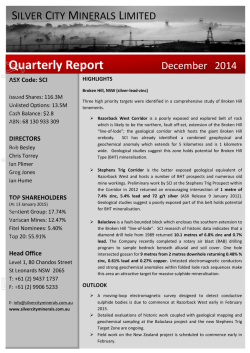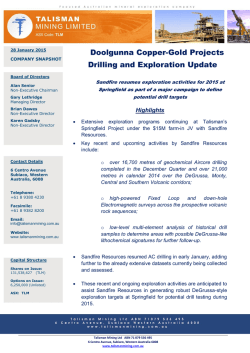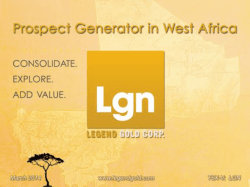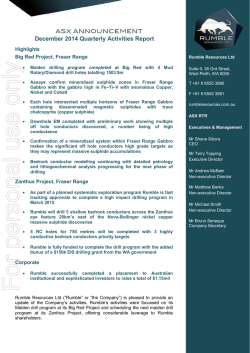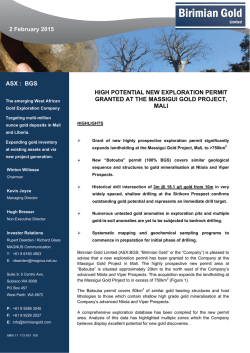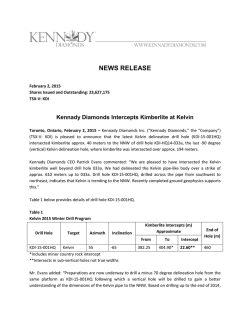
Quarterly Activities Report
30 January 2015 ASX Code: SEG Market Announcements Platform ASX Limited Exchange Centre, 20 Bridge Street Sydney NSW 2000 QUARTERLY ACTIVITIES REPORT FOR THE PERIOD ENDED 31 DECEMBER 2014 DECEMBER QUARTER HIGHLIGHTS Diamond hole PD001 at E21 Target intersected ultramafic rocks with magmatic sulphides Extensive gravity survey commenced to identify phase 2 drilling targets Plumridge tenements consolidated – Segue now owns 100% of over 3,000km2 of tenements Diamond hole PAD001 completed at Pardoo Project (EIS co-funded drill hole) Key Facts: Segue Resources Limited ASX Code: SEG Share price (29/1/15): 0.7¢ 52 week range: 0.4¢-1.8¢ Shares on issue: 2,026.6m Market cap.: $14.2m Plumridge Nickel Project Location: Fraser Range, WA Primary commodity: Nickel-copper Tenement holding (100%): 3,107km2 Board and Management Figure 1: Plumridge Nickel Project location map Steven Michael Managing Director Dr Frazer Tabeart Non-Exec. Director Nicholas Ong Non-Exec. Director Matthew Foy Company Secretary Peter Langworthy Page 1 Consulting Geologist PLUMRIDGE NICKEL PROJECT Fraser Range Province, Western Australia (Segue 100%) Segue continued to explore, expand and consolidate its exploration tenement package at the Plumridge Project in the Fraser Range. Segue now controls ~3,100km2 of contiguous granted exploration licences at Plumridge. During the quarter, Segue announced the acquisition of its minority joint venture partner’s interest in the Plumridge East JV (see announcement on 22 December 2014) which contains the Company’s priority exploration area, E21 Target. Segue now owns a 100% interest in all of its Plumridge tenements. Maiden Deep Drilling Programme Segue completed its maiden diamond and reverse circulation (RC) drilling programme at the E21 Target during the quarter. The E21 Target covers the northern portion of a large, ovoid magnetic feature that is interpreted to be an intrusion or series of intrusions in a major fold structure within E39/1731 (Figure 2). As previously reported (ASX announcement 14 August 2014), Moving Loop Electromagnetic (MLEM) and Fixed Loop Electromagnetic (FLEM) surveys were undertaken and successfully defined five bedrock conductors. The drill programme was designed to test the three highest priority conductors (C1, C2 and C4). Figure 2 – E21 Target (left) and EM conductor targets (right) Table 1 – Plumridge drill hole information Hole ID Type Easting Northing Dip Azimuth EOH PD001 RC pre-collar 653,798 6,655,102 -80° 105° 346.1m -80° 105° 843.5m Diamond PRC002 RC 650,603 6,655,552 -60° 140° 196m PRC003 RC 654,456 6,656,057 -65° 290° 298m Page 2 PD001 intersected 7 horizons (up to 15 metres thick) of pyroxenite (ultramafic intrusive rocks). These rocks confirmed the presence in the sequence of the target mafic-ultramafic rocks that are considered the prospective host to nickel-copper sulphides. The pyroxenite intrusions contained disseminated sulphides that are magmatic and are predominantly pyrrhotite and pyrite (iron sulphides) with trace chalcopyrite (copper sulphide). The sulphides demonstrate that the critical process of sulphur saturation has occurred within the magmatic system (Figure 3). All assay data has been received and confirm the magmatic sulphides are predominantly pyrrhotite and pyrite, with minor chalcopyrite. Figure 3 – Diamond core from PD001 with pyroxenite hosting magmatic sulphides PD001 intersected the targeted C1 Conductor, as modelled, at a depth of 631.3 metres. The drill hole intersected a shear zone containing pyroxenitic rocks (containing sulphides) and graphite bearing (5-10%) schist. A downhole electromagnetic survey completed in PD001 confirmed this shear zone as the source of the conductor. The C2 and C4 Targets were successfully tested and in each case intersected graphitic schists. Detailed Aeromagnetic Survey During the quarter Segue engaged Thomson Aviation to acquire high resolution (100 metre line spaced) aeromagnetic data on E39/1731 to bring the data asset of this block up to the same standard as the rest of the Plumridge Nickel portfolio. The survey was completed in August and the data processed and interpreted by Segue’s geophysical consultants, Newexco. PD001 has identified magmatic sulphides hosted by pyroxenitic rocks confirming the potential for a maficultramafic intrusive-hosted magmatic sulphide “event” at the E21 Target. The recently acquired detailed airborne magnetics over E39/1731 show the presence of a distinct “bullseye” magnetic feature approximately 1 kilometre to the west of the drilling. This magnetic target is inferred to represent a larger mafic-ultramafic intrusion with the potential to host nickel-copper sulphides. The pyroxenite lenses in PD001 are being interpreted as peripheral sills/dykes to this larger mafic-ultramafic intrusion (Figures 4, 5 & 6). Page 3 Figure 4 – E21 target showing magnetic image with drilling, modelled conductor plates and magnetic targets Figure 5 – Schematic cross-section showing the position of PD001 in relation to interpreted magnetic body Page 4 Figure 6 – Interpreted cross section showing the inferred position of a large-scale mafic-ultramafic intrusion Major Gravity Survey Commenced During the quarter Segue commenced a large-scale, multi-phase gravity survey at the Plumridge Nickel Project. The survey is designed to provide immediate detailed coverage over key target areas (E21 Target and E28 Target) whilst also collecting regional data across the majority of the project area (Figures 7 & 8). The purpose of the survey is to capture a high quality data set that can be integrated with the existing detailed airborne magnetic data to generate and better define quality targets for follow-up drilling and electromagnetic surveys. The application of 3D Inversion Modeling will be central to this work. This approach is based on the understanding taken from published data on the Nova Nickel-Copper Deposit that whilst the magnetic data indicates key geological features of interest (e.g. the Nova "Eye"), the intrusions that host the Nova-Bollinger deposits are identified in the gravity data. Electromagnetic surveys can then be focused on priority coincident gravity-magnetic features to produce direct drilling targets. The program consists of an immediate detailed survey at the E21 Target on an 800m x 100m station spacing. This information will be used in conjunction with the airborne magnetic data to target the presence of maficultramafic intrusions within the target area. The gravity survey at the E21 Target has commenced and interpretation, 3D Inversion Modelling and target generation is expected to be completed during 1Q 2015. The survey will then move to the regional areas (1,600m x 100m) to provide an excellent regional dataset that will be critical to generate the next phase of targets. Infill surveying will be completed as required based on results. The entire survey is expected to be completed during 2Q 2015. Figure 7 – Detailed gravity survey at E21 Target Page 5 Figure 8 – Regional gravity survey coverage Gravity survey lines (Black lines) - Regional coverage – 1600m x 100m Segue tenements (Blue) / Detailed survey (800m x 100m) at E21 Target area (Pink) Airborne Magnetic Data – New Targets With the completion of the detailed airborne magnetic survey covering E39/1731, the entire Plumridge Project is now covered in high-quality 100 metre line spaced data. This data will continue to form the basis for targeting across the wider project area (Figure 9). The priority target areas across the project are focused on “ovoid” fold features that are considered to be the preferred sites for mafic-ultramafic intrusions (the host to the targeted nickel-copper sulphide deposits). These areas will be covered as part of the gravity program and reconnaissance programs of aircore drilling will also be undertaken on selected targets. These programs will then form the basis for more targeted exploration (i.e. electromagnetic surveys and reverse circulation (RC) and diamond drilling). Page 6 Figure 9 – Large scale magnetic targets PARDOO NICKEL PROJECT Pilbara Region, Western Australia (Segue 100%) The Pardoo Ni-Cu Project is located in the Northern Pilbara, 100 kilometres east of the regional centre of Port Hedland (Figure 10). The project is prospective for magmatic nickel-copper sulphides. A current inferred resource of 44.7mt @ 0.3% Ni & 0.13% Cu exists at the sedimentary hosted Highway Deposit. The exploration model is that the source of the nickel and copper mineralisation was derived from what is interpreted to be a large scale mafic-ultramafic intrusive complex to the north of the major fault zone (Pardoo Fault). Figure 10 – Pardoo location map and interpreted geology Page 7 A revitalised exploration effort at the project over the previous year has defined a coincident geophysical anomaly identified through various phases of airborne magnetic, gravity and fixed loop electromagnetic (FLEM) surveying. The regional gravity anomaly of interest, interpreted as a series of gabbroic, maficultramafic intrusions is covered by a sequence (50-100m) of sedimentary rocks, the Callawa Formation. To provide an initial test of this concept a single Exploration Incentive Scheme (EIS) co-funded diamond drill hole was completed in November 2014 (Table 2). Under the EIS, the Department of Mines and Petroleum will reimburse Segue 50% of its drilling costs to a maximum refund of $60,000. Table 2 – Pardoo drill hole information Hole ID Type Easting Northing Dip Azimuth EOH PAD001 Diamond 768,872 7,763,903 -90° 360° 522.2m Figure 11 – Drilling of diamond hole PAD001 at the Pardoo Nickel Project Diamond hole PAD001 was drilled to a total depth of 522.3 metres and successfully intersected a 225 metre thick mafic intrusion (gabbro) hosting trace amounts of disseminated pyrite-pyrrhotite-magnetite (Figure 12). The mafic intrusion is hosted within a sequence of basalts and volcanoclastic sediments. Assay results and the results of a down hole electromagnetic (DHEM) survey are currently outstanding. The results confirm that the large-scale geophysical target is most likely a multi-phase mafic-ultramafic intrusive complex. These types of intrusions are highly prospective for mafic-ultramafic hosted nickelsulphide deposits. Page 8 Figure 12 – Diamond Hole PAD001 Drill Core With the successful interception of a sulphide bearing, mafic, gabbroic intrusion, further work is planned for 2015 in the form of a detailed gravity survey and further ground based electro-magnetic surveys to delineate further targets worthy of drill testing. CORPORATE AND FINANCIAL Acquisition of 100% Interest in Plumridge East Joint Venture During the quarter Segue advised that it had entered into an unconditional agreement to acquire Fraser Range Metals Group Limited’s interest in the Plumridge East Joint Venture (Joint Venture) for $200,000. Segue was earning an 80% interest in the Joint Venture which covered two tenements (E39/1731 and E28/2317) at the Plumridge Nickel Project. Following completion of the transaction (completed in January 2015) Segue now owns a 100% interest in the Joint Venture. Option Lapse During the quarter the Company advised that 11,800,000 options exercisable at $0.051 on or before 8 November 2014 had lapsed unexercised. Share Capital At the end of the quarter the Company had 2,004,261,397 ordinary shares on issue. The Company also had 15,000,000 options exercisable at $0.01 on or before 18 February 2018 and 76,500,000 options exercisable at $0.018 on or before 31 January 2016 outstanding. Page 9 For further information visit www.segueresources.com or contact: Segue Resources Limited Mr Steven Michael Managing Director T: +61 8 9383 3330 E: [email protected] Competent Persons Statement The information in this report that relates to Exploration Results is based on information compiled by Mr Peter Langworthy who is a Member of The Australian Institute of Geoscientists. Mr Langworthy has more than five years’ experience which is relevant to the style of mineralisation and type of deposit under consideration and to the activity which he is undertaking to qualify as a Competent Person as defined in the 2012 Edition of the “Australasian Code for Reporting of Exploration Results, Minerals Resources and Ore Reserves”. Mr Langworthy consents to the inclusion in the report of the matters based on his information in the form and context in which it appears. Page 10 Appendix A – Schedule of Tenements as at 31 December 2014 Status Interest at beginning of quarter Interest acquired or disposed Interest at end of quarter E28/1475 Granted 100% 0% 100% E28/2266 Granted 100% 0% 100% E28/2267 Granted 100% 0% 100% E28/2317 Granted 0% 100% 100% E28/2387 Granted 100% 0% 100% E28/2388 Granted 100% 0% 100% E28/2391 Granted 100% 0% 100% E39/1084 Granted 100% 0% 100% E39/1117 Granted 100% 0% 100% E39/1118 Granted 100% 0% 100% E39/1709 Granted 0% 100% 100% E39/1710 Granted 100% 0% 100% E39/1731 Granted 0% 100% 100% E28/2385 Pending 0% 0% 0% E28/2390 Pending 0% 0% 0% E28/2392 Pending 0% 0% 0% E28/2393 Pending 0% 0% 0% E39/1830 Pending 0% 0% 0% Tenement ID Plumridge Project Page 11 Status Interest at beginning of quarter Interest acquired or disposed Interest at end of quarter E63/1521 Granted 100% 0% 100% E63/1522 Granted 100% 0% 100% E63/1523 Granted 100% 0% 100% E63/1524 Granted 100% 0% 100% E45/18661 Granted 100% 0% 100% E45/3383 Granted 100% (100%) 0% E45/4279 Granted 0% 100% 100% Tenement ID Deralinya Project Pardoo Project 1 During the quarter the Company reduced the tenement size from 34 graticular blocks to 28 graticular blocks. Page 12 JORC Code, 2012 Edition – Table 1 report template Section 1 Sampling Techniques and Data (Criteria in this section apply to all succeeding sections.) Criteria JORC Code explanation Commentary · Nature and quality of sampling (eg cut channels, random chips, or specific specialised industry standard measurement tools appropriate to the minerals under investigation, such as down hole gamma sondes, or handheld XRF instruments, etc). These examples should not be taken as limiting the broad meaning of sampling. · Include reference to measures taken to ensure sample representivity and the appropriate calibration of any measurement tools or systems used. Sampling techniques · Aspects of the determination of mineralisation that are Material to the Public Report. · In cases where ‘industry standard’ work has been done this would be relatively simple (eg ‘reverse circulation drilling was used to obtain 1 m samples from which 3 kg was pulverised to produce a 30 g charge for fire assay’). In other cases more explanation may be required, such as where there is coarse gold that has inherent sampling problems. Unusual commodities or mineralisation types (eg submarine nodules) may warrant disclosure of detailed information. Page 13 Sampling consisted of 3m composite samples of quarter core from all core. Samples were cut using a diamond blade core saw. Duplicate samples were collected every ~20th sample for QAQC purposes. Sampling is considered to be comprehensive and representative. Remaining core was retained as a permanent reference. - Assay results and Down Hole Electro-magnetic (DHEM) results are outstanding at the time of writing this report. Criteria JORC Code explanation Drilling techniques Drill sample recovery · Drill type (eg core, reverse circulation, open-hole hammer, rotary air blast, auger, Bangka, sonic, etc) and details (eg core diameter, triple or standard tube, depth of diamond tails, face-sampling bit or other type, whether core is oriented and if so, by what method, etc). · Method of recording and assessing core and chip sample recoveries and results assessed. · Measures taken to maximise sample recovery and ensure representative nature of the samples. · Whether a relationship exists between sample recovery and grade and whether sample bias may have occurred due to preferential loss/gain of fine/coarse material. · Whether core and chip samples have been geologically and geotechnically logged to a level of detail to support appropriate Mineral Resource estimation, mining studies and metallurgical studies. Logging · Whether logging is qualitative or quantitative in nature. Core (or costean, channel, etc) photography. · The total length and percentage of the relevant intersections logged. Commentary Diamond drilling was undertaken. Core sizes collected were HQ and NQ in 3m intervals. Core was orientated. Core recovery was routinely recorded every metre by a trained geologist. Core recovery was deemed poor through the sedimentary Callawa Fm, 65% recovery, whilst from 55.4m (Arcaean) onwards recovery typically ranged between 98-100%. At this stage it is unsure whether a relationship exists between grades and core loss. All holes were logged by a qualified and experienced geologist. All logging included descriptions of geotechnical, mineralisation, structural and lithological aspects of the core and was digitally recorded using an industry standard code system. Core was formally photographed. Data collected offers sufficient detail for the purpose of interpretation and further studies. · If core, whether cut or sawn and whether quarter, half or all core taken. · If non-core, whether riffled, tube sampled, rotary split, etc and whether sampled wet or dry. Sub-sampling techniques and sample preparation · For all sample types, the nature, quality and appropriateness of the sample preparation technique. · Quality control procedures adopted for all sub-sampling stages to maximise representivity of samples. · Measures taken to ensure that the sampling is representative of the in situ material collected, including for instance results for field duplicate/second-half sampling. Page 14 Quarter core was cut using a diamond core saw and collected for assay. 3 metre composite sampling was deemed to be comprehensive and representative for the style/type of mineralisation under investigation. Duplicate samples were taken (remaining quarter core) approximately every ~20th sample for QAQC purposes Criteria JORC Code explanation · The nature, quality and appropriateness of the assaying and laboratory procedures used and whether the technique is considered partial or total. Quality of assay data and laboratory tests · For geophysical tools, spectrometers, handheld XRF instruments, etc, the parameters used in determining the analysis including instrument make and model, reading times, calibrations factors applied and their derivation, etc. · Nature of quality control procedures adopted (eg standards, blanks, duplicates, external laboratory checks) and whether acceptable levels of accuracy (ie lack of bias) and precision have been established. · The verification of significant intersections by either independent or alternative company personnel. Verification of sampling and assaying · · Documentation of primary data, data entry procedures, data verification, data storage (physical and electronic) protocols. · Location of data points Data spacing and distribution Samples were submitted to ALS laboratories (Perth). Samples will be pulverised to 80 microns. Samples will dissolve with 4 acids and analysed via ICP with Mass spectrometer. The laboratory procedures are considered to be appropriate for reporting multi-element assays.. The insertion of CRM's and duplicates every ~20 samples by SEG will be used as an internal means of QAQC of laboratory standards. No issues were encountered. Significant intersections have been verified by consulting geologists to the group, OMNI GeoX Pty. Ltd. No holes have been twinned. All data has been captured digitally upon logging and stored digitally securely within the Perth head office database. Discuss any adjustment to assay data. · Accuracy and quality of surveys used to locate drill holes (collar and down-hole surveys), trenches, mine workings and other locations used in Mineral Resource estimation. · Specification of the grid system used. · Quality and adequacy of topographic control. · Data spacing for reporting of Exploration Results. · Whether the data spacing and distribution is sufficient to establish the degree of geological and grade continuity appropriate for the Mineral Resource and Ore Reserve estimation procedure(s) and classifications applied. · Page 15 The use of twinned holes. Commentary Whether sample compositing has been applied. All XYZ surveying was collected using a handheld Garmin GPS accurate to ±4m. Projection and Grid system used: GDA94 MGAZ50. A single hole exploration hole was undertaken. Criteria JORC Code explanation Orientation of data in relation to geological structure Sample security Audits or reviews · Whether the orientation of sampling achieves unbiased sampling of possible structures and the extent to which this is known, considering the deposit type. · If the relationship between the drilling orientation and the orientation of key mineralised structures is considered to have introduced a sampling bias, this should be assessed and reported if material. · · data. The measures taken to ensure sample security. The results of any audits or reviews of sampling techniques and Commentary The orientation of the drilling is not expected to introduce sampling bias. Samples were packaged and stored in secure storage from the time of gathering through to submission. Laboratory best practice methods were employed by the laboratory upon receipt. An audit of the sampling technique and data was carried out by consulting geologists to the group, OMNI GeoX Pty. Ltd. and deemed to have been satisfactory. Section 2 Reporting of Exploration Results (Criteria listed in the preceding section also apply to this section.) Criteria JORC Code explanation · Type, reference name/number, location and ownership including agreements or material issues with third parties such as joint ventures, partnerships, overriding royalties, native title interests, historical sites, wilderness or national park and environmental settings. Mineral tenement and land tenure status · The security of the tenure held at the time of reporting along with any known impediments to obtaining a licence to operate in the area. Page 16 Commentary Work was undertaken upon permit E45/1866 • The tenements are located in the North Pilbara of Western Australia, 100km East of Port Hedland within the Pardoo pastoral lease. • Tenements are held 100% by Segue (Pardoo) Pty. Ltd. A wholly owned subsidiary of Segue Resources Ltd. • No overriding royalties are in place • There is no native title agreement required • Tenure does not coincide with any historical sites or national parkland • Semi-arid, thinly vegetated, relatively flat to low lying hills with sub-cropping rock. • Tenements are currently secure and in good standing. Criteria JORC Code explanation Exploration done by other parties · Acknowledgment and appraisal of exploration by other parties. Geology · Deposit type, geological setting and style of mineralisation. Commentary Various phases of exploration by CRA, Mithril and Segue focussing upon the Pardoo Fault Zone and Highway Resource. Geologically, the project is located on the northern edge of the Achaean East Pilbara GraniteGreenstone terrane. The DeGrey structural zone (known at a project scale as the Pardoo Fault), a large regionally pervasive structure, runs through the project and is believed to be integral to mineralisation at the Highway Deposit. The relatively thin (0-100m), flat lying, Mesozoic aged Callawa Formation covers nearly all prospective stratigraphy. Style of mineralisation under investigation is Ni-Cu sulphide hosted within maficultramafic intrusions. · A summary of all information material to the understanding of the exploration results including a tabulation of the following information for all Material drill holes: o easting and northing of the drill hole collar o elevation or RL (Reduced Level – elevation above sea level in metres) of the drill hole collar o dip and azimuth of the hole Drill hole Information o down hole length and interception depth o hole length. · If the exclusion of this information is justified on the basis that the information is not Material and this exclusion does not detract from the understanding of the report, the Competent Person should clearly explain why this is the case. Page 17 Refer to table within text. Criteria JORC Code explanation Commentary · In reporting Exploration Results, weighting averaging techniques, maximum and/or minimum grade truncations (eg cutting of high grades) and cut-off grades are usually Material and should be stated. Data aggregation methods · Where aggregate intercepts incorporate short lengths of high grade results and longer lengths of low grade results, the procedure used for such aggregation should be stated and some typical examples of such aggregations should be shown in detail. To be stipulated once results are received. · The assumptions used for any reporting of metal equivalent values should be clearly stated. · These relationships are particularly important in the reporting of Exploration Results. Relationship between mineralisation widths and intercept lengths · If the geometry of the mineralisation with respect to the drill hole angle is known, its nature should be reported. · If it is not known and only the down hole lengths are reported, there should be a clear statement to this effect (eg ‘down hole length, true width not known’). Most drilling has intersected mineralised zones at a near perpendicular angle and as so true widths can inferred by the reader. Diagrams · Appropriate maps and sections (with scales) and tabulations of intercepts should be included for any significant discovery being reported These should include, but not be limited to a plan view of drill hole collar locations and appropriate sectional views. Refer to figures within text. Balanced reporting · Where comprehensive reporting of all Exploration Results is not practicable, representative reporting of both low and high grades and/or widths should be practiced to avoid misleading reporting of Exploration Results. Representative reporting of low and high will be effected within future report. Other substantive exploration data · Other exploration data, if meaningful and material, should be reported including (but not limited to): geological observations; geophysical survey results; geochemical survey results; bulk samples – size and method of treatment; metallurgical test results; bulk density, groundwater, geotechnical and rock characteristics; potential deleterious or contaminating substances. Page 18 All previous exploration reported within previous ASX releases. Assay and DHEM results followed by potential gravity and or FLEM surveys over key targets. Criteria JORC Code explanation · The nature and scale of planned further work (eg tests for lateral extensions or depth extensions or large-scale step-out drilling). Further work · Diagrams clearly highlighting the areas of possible extensions, including the main geological interpretations and future drilling areas, provided this information is not commercially sensitive. Page 19 Commentary
© Copyright 2024
